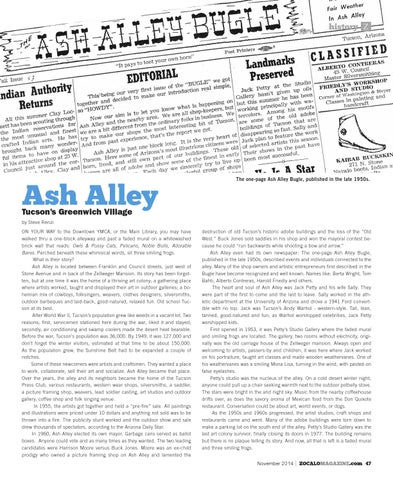history Z
Ash Alley
The one-page Ash Alley Bugle, published in the late 1950s.
Tucson’s Greenwich Village by Steve Renzi
On your way to the Downtown YMCA, or the Main Library, you may have walked thru a one-block alleyway and past a faded mural on a whitewashed brick wall that reads: Owls & Pussy Cats, Pelicans, Noble Bulls, Adorable Bares. Perched beneath these whimsical words, sit three smiling frogs. What is their story? Ash Alley is located between Franklin and Council streets, just west of Stone Avenue and in back of the Zellweger Mansion. Its story has been forgotten, but at one time it was the home of a thriving art colony; a gathering place where artists worked, taught and displayed their art in outdoor galleries; a bohemian mix of cowboys, folksingers, weavers, clothes designers, silversmiths, outdoor barbeques and laid-back, good-natured, relaxed fun. Old school Tucson at its best. After World War II, Tucson’s population grew like weeds in a vacant lot. Two reasons; first, servicemen stationed here during the war, liked it and stayed; secondly, air conditioning and swamp coolers made the desert heat bearable. Before the war, Tucson’s population was 36,000. By 1949, it was 127,000 and don’t forget the winter visitors, estimated at that time to be about 150,000. As the population grew, the Sunshine Belt had to be expanded a couple of notches. Some of these newcomers were artists and craftsmen. They wanted a place to work, collaborate, sell their art and socialize. Ash Alley became that place. Over the years, the alley and its neighbors became the home of the Tucson Press Club, various restaurants, western wear shops, silversmiths, a saddler, a picture framing shop, weavers, lead soldier casting, art studios and outdoor gallery, coffee shop and folk singing venue. In 1955, the artists got together and held a “pre-fire” sale. All paintings and illustrations were priced under 10 dollars and anything not sold was to be thrown into a fire. The publicity stunt worked and the outdoor show and sale drew thousands of spectators, according to the Arizona Daily Star. In 1960, Ash Alley elected its own mayor. Garbage cans served as ballot boxes. Anyone could vote and as many times as they wanted. The two leading candidates were Harrison Moore versus Buck Jones. Moore was an ex-child prodigy who owned a picture framing shop on Ash Alley and lamented the
destruction of old Tucson’s historic adobe buildings and the loss of the “Old West.” Buck Jones sold saddles in his shop and won the mayoral contest because he could “run backwards while shooting a bow and arrow.” Ash Alley even had its own newspaper: The one-page Ash Alley Bugle, published in the late 1950s, described events and individuals connected to the alley. Many of the shop owners and artistic entrepreneurs first described in the Bugle have become recognized and well known. Names like: Berta Wright, Tom Bahti, Alberto Contreras, Harold Friedly and others. The heart and soul of Ash Alley was Jack Petty and his wife Sally. They were part of the first to come and the last to leave. Sally worked in the athletic department at the University of Arizona and drove a 1941 Ford convertible with no top. Jack was Tucson’s Andy Warhol - western-style. Tall, lean, tanned, good-natured and fun, as Warhol worshipped celebrities, Jack Petty worshipped kids. First opened in 1953, it was Petty’s Studio Gallery where the faded mural and smiling frogs are located. The gallery, two rooms without electricity, originally was the old carriage house of the Zellweger mansion. Always open and welcoming to artists, passers-by and children, it was here where Jack worked on his portraiture, taught art classes and made wooden weathervanes. One of his weathervanes was a smiling Mona Lisa, turning in the wind, with pasted-on false eyelashes. Petty’s studio was the nucleus of the alley. On a cold desert winter night, anyone could pull up a chair seeking warmth next to the outdoor potbelly stove. The stars were bright in the arid night sky. Music from the nearby coffeehouse drifts over, as does the savory aroma of Mexican food from the Don Quixote restaurant. Conversation could be about art, world events, or dogs. As the 1950s and 1960s progressed, the artist studios, craft shops and restaurants came and went. Many of the adobe buildings were torn down to make a parking lot on the south end of the alley. Petty’s Studio Gallery was the last art colony survivor, finally closing its doors in 1977. The building remains but there is no plaque telling its story. And now, all that is left is a faded mural and three smiling frogs. November 2014 | ZOCALOMAGAZINE.com 47
